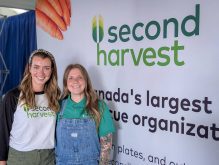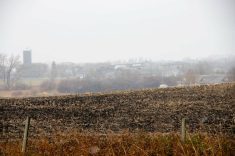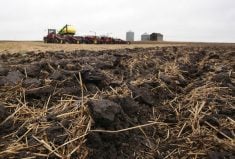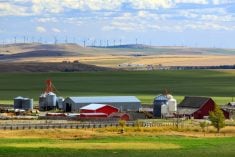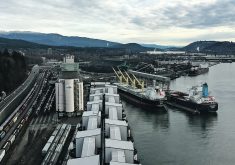Producers say Russia’s invasion of Ukraine and questionable government policies are threatening world food stocks
CHARLOTTETOWN, P.E.I. — Disruption is threatening both food security and the farmers who produce that food, panelists from Europe and North America said at a recent conference.
For decades, said Ted Bilyea, special adviser to the Canadian Agri-Food Policy Institute, farmers have been dealing with the challenges of abundance. They worried about productivity growing faster than demand.
It’s becoming more difficult to view agriculture through that lens because of floods, droughts, diseases, trade disruption, climate change and the pandemic.
“However, it took a war in one of the world’s great grain and oilseed surplus countries to turn the illusion of abundance on its head and move the issues of food security to the top of the agenda,” Bilyea told the North American European Union farm leaders conference.
Read Also

New coal mine proposal met with old concerns
A smaller version of the previously rejected Grassy Mountain coal mine project in Crowsnest Pass is back on the table, and the Livingstone Landowners Group continues to voice concerns about the environmental risks.
Markets shot skyward after Russia’s invasion of Ukraine, and while they have eased, the food price index remains high by historic standards, he said, signalling an ongoing food security risk.
Palle Borgstrom, a Swedish dairy farmer and vice-president of COPA, the European farm lobby, said the war is affecting European countries differently, depending on how close they are to Russia. Food security concerns are rising, he said.
The debate around food security is heightened in Finland and the Baltic states, he said.
“You can ask any person in Finland how long the border is to Russia and they will know it’s 1,340 kilometres,” he said.
“Everyone knows the answer because they have lived with that neighbour and the threat of that neighbour for a very, very long time.”
Finland already had an ambitious food security program, maintaining a six-month supply of grain stocks. It has now increased that to eight months’ worth.
The Baltic countries are also preparing, but other countries haven’t recognized the need for that yet, he said.
Instead, they are focusing on government demands and policies that will threaten food supply.
In Ireland, for example, a proposal would require dairy farmers to lower stocking rates. In Germany, animal welfare and environmental measures have reduced pork production by 25 percent, he said.
“In Denmark, we have an intensive discussion about the CO2 tax that will hit the agriculture sector quite severely. In the Netherlands, the state and the government is buying out farmers to use that land to rewild and put back to nature restoration,” Borgstrom said.
His own country only produces about half of what it needs, and he said politicians are naïve about what proposals such as the Farm to Fork strategy will do.
Research has shown production will drop 10 to 20 percent while food prices rise 20 to 40 percent, he said. Europe is already seeing that due to supply chain disruptions, the war, energy prices and inflation.
Borgstrom said consumers are turning their backs on premium products and moving to discount stores, which will mean less revenue for farmers.
This is happening in the absence of the Farm to Fork initiative. If the two were layered, the result would be “extremely dangerous,” he said.
Bilyea said the world is struggling with 349 million people in 82 countries facing food insecurity; 50 million are on the brink of famine.
Growing populations and income will increase demand for protein, and that has to come from productivity gains, he said. Last year the Organization for Economic Co-operation and Development concluded the world requires productivity growth of 24 percent in crops and 31 percent in animals by 2050 to avoid an increase in hunger on top of what already exists.
At the same time, the World Bank said productivity growth has slowed by 21 percent due to climate change.
“You’re going in different directions,” said Bilyea.
The same institution said that business as usual would double emissions from agriculture by 2040 and require 138.4 million acres of new land in production, or just less than half the land that China farms.
“I think we should just accept the concept that we should plan for the worst and hope for the best,” he said.
Bilyea presented data showing that the largest producing countries, such as China and India, are also among the largest net importers. Japan, South Korea, Taiwan, other parts of Asia and Africa are all doing the same.
The additional imports are coming from North America, South America and non-European Union countries in eastern Europe, including Ukraine.
He said the world is “living rather dangerously” when he looks at world grain stocks, less those in China, that indicate about six weeks of corn, nine weeks of rice and 10 weeks of wheat.
“How can we increase the stocks without shorting other parts of the food system?” said Bilyea.
“That remains a huge question, I think, for all of us.”
There could be lessons from China, which is dealing with food security through four broad measures. One is to not let arable land drop below 296.5 million acres and maintain a significant supply of pork and vegetables.
“Maintaining farmland for all of us, I think, is our first line of resilience. I don’t know if we’d do it the way China is suggesting, but that’s what effectively needs to happen globally,” Bilyea said.
The second is to stabilize grain production and increase soybeans. Bilyea said China will still need to import about 100 million tonnes of soybeans for pork production.
Thirdly, China is investing heavily in agricultural technology, including biotech, to create resilience.
The final measure is to diversify the food supply.
Bilyea said that really means to diversify away from the West, which likely means getting food from suboptimal places where more inputs are required or there is reduction of things like the rainforest.
“The learning for all net importers should be to prioritize the development of sustainable international trade to achieve food security,” he said.
“That means bringing some certainty and business continuity to procurement that will allow sustainable exporters to invest to achieve productivity gains needed for food security.”







